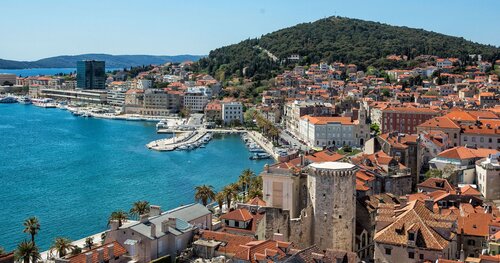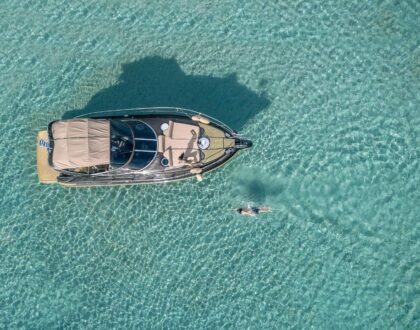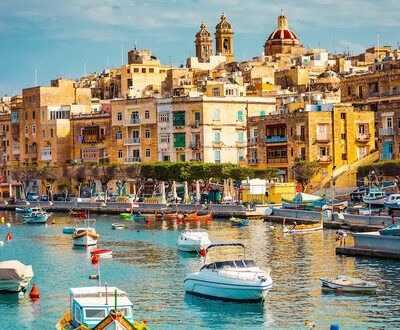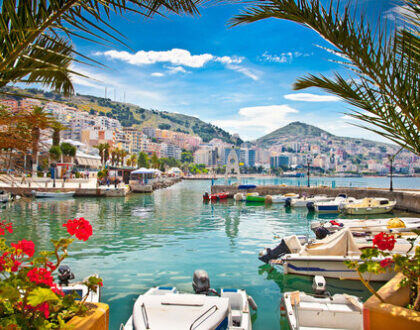Split – Croatia Cruise Tour Information

SPLIT, CROATIA
Lying on the Adriatic Sea’s eastern shore, Split is known for its terracotta roofs, whitewash buildings, palm tree-lined promenade and azure waters. Split has a long history, as it’s home to Diocletian’s Palace and the Cathedral of Saint Domnius, which were built for the Roman emperor in the 4th century. Always buzzing with tourists, Split balances its historic setting with a plethora of modern restaurants, bars and shops. Thanks to its Mediterranean climate, Split receives over 2,600 hours of sunshine every year. Jump onboard a Croatia cruise and take advantage of its sunny weather by exploring its beautiful beaches — most namely Bacvice and Kastelet Beaches — year-round.
THINGS TO DO IN SPLIT
DISCOVER DIOCLETIAN’S PALACE
One of the world’s most dominant Roman ruins, Diocletian’s Palace (and its nearby cathedral) was constructed over 10 years in the mid-4th century. There are 220 buildings within its boundaries, which include homes, bars, hotels and cafes. The palace’s cellar was used in season four of Game of Thrones, as Daenerys’ Throne Room.
AIM FOR THE ADRIATIC
Split is home to both sandy and pebbly beaches, which have calm turquoise waters. Radisson Blu Resort manages Trstenik Beach, which has umbrellas and sun lounges. Bacvice is the most popular and central beach option. About a 20-minute walk from Split is Kastelet Beach and its beachfront bars, too.
ISLAND HOP
Although Split is beautiful, make the most of your time on the Croatian coast and visit one of its neighbors. Island spot on your breezy catamaran ride from Split to Hvar, which only takes one hour. On the island, bike along the Stari Grad Plain and visit Stari Grad and its historic buildings, including Tvrdalj Castle. Meanwhile, Brac Island is only 50 minutes from Split and is home to beautiful beaches, such as Punta Rata and Zlatni Rat.
LOCAL CUISINE
Split’s cuisine is a mix of Croatian and Italian specialties. Located in Diocletian Palace’s western gate, Poseidon Restaurant serves fresh seafood such as octopus, fish and oysters, and black cuttlefish risotto, a traditional Croatian dish that’s made with cuttlefish ink. Along the Riva visit Brasserie on 7, with its delicious platters of prawns, clams and tuna, as well as charcuterie and cheese.
SHOPPING
A traditional Croatian souvenir is a licitar heart — a unique way to show someone you loved them in the 16th century. They’re bright red and edible, but most people use them today as Christmas decorations. To remember your cruise to Split, Croatia, visit Break Time for unique nautical-themed bracelets.
With its seafront cafés and ancient alleyways, shouting stallholders and travellers on the move, bustling, exuberant Split is one of Croatia’s and the Mediterranean’s most compelling cities, it’s easy to see this feeling when you step aground from your cruise.
It has a unique historical heritage too, having grown out of the palace built here by the Roman Emperor Diocletian in 295AD. The palace remains Split’s central ingredient, having been gradually transformed into a warren of houses, tenements, churches and chapels by the various peoples who came to live here after Diocletian’s successors had departed.
Adapted long ago to serve as Split’s town centre, Diocletian’s Palace is certainly not an archaeological “site”. Although set-piece buildings such as Diocletian’s mausoleum (now the cathedral) and the Temple of Jupiter (now a baptistery) still remain, other aspects of the palace have been tinkered with so much by successive generations that it is no longer recognizable as an ancient Roman structure. Best place to start exploring with a excursion the seaward side of the palace is Split’s broad and lively Riva.
Running along the palace’s southern facade, into which shops, cafés and a warren of tiny flats have been built, the Riva is where a large part of the city’s population congregates day and night to meet friends, catch up on gossip or idle away an hour or two in a café. Nearly everything worth seeing in Split is concentrated in the compact Old Town behind the waterfront Riva, made up in part of the various remains and conversions of Diocletian’s Palace itself, and the medieval additions to the west of it. You can walk across this area in about ten minutes, although it would take a lifetime to explore all its nooks and crannies.
Recommended Posts

Summer Fun!
February 01, 2023

Valletta – Malta Cruise Tour Information
January 31, 2023

Sarande – Albania Cruise Tour Information
January 31, 2023
